My wife used to subscribe to a magazine titled Budget Traveler, which features low-cost vacations and tips like turning your sport coat inside out to prevent wrinkles in the suitcase. I didn’t care for the name because it implied its readers were cheapskates. I know what I can afford and will be the judge of that. Would you subscribe to a magazine called Budget Sailor?I didn’t think so. You also know what you can afford. Not all of us earn six figures and can purchase boats that cost as much. As an interesting exercise, we decided to see what cruising boats one can buy for less than $50,000. Turns out, quite a few. I ought to know; I’ve never bought one costing more. Just a few years ago I set out to buy an older sailboat with just that budget — I mean max price.For this survey, the hundreds of choices were narrowed to a mere 10 affordable sailboats — no easy task. Our criteria: cruising priorities such as tankage, stowage, manageable rig, tracking, etc.; at least average or above-average quality of construction; enduring design; and resale value. Many good boats ended up on the cutting-room floor. And I will admit to my prejudices. For what it’s worth, here’s my list.
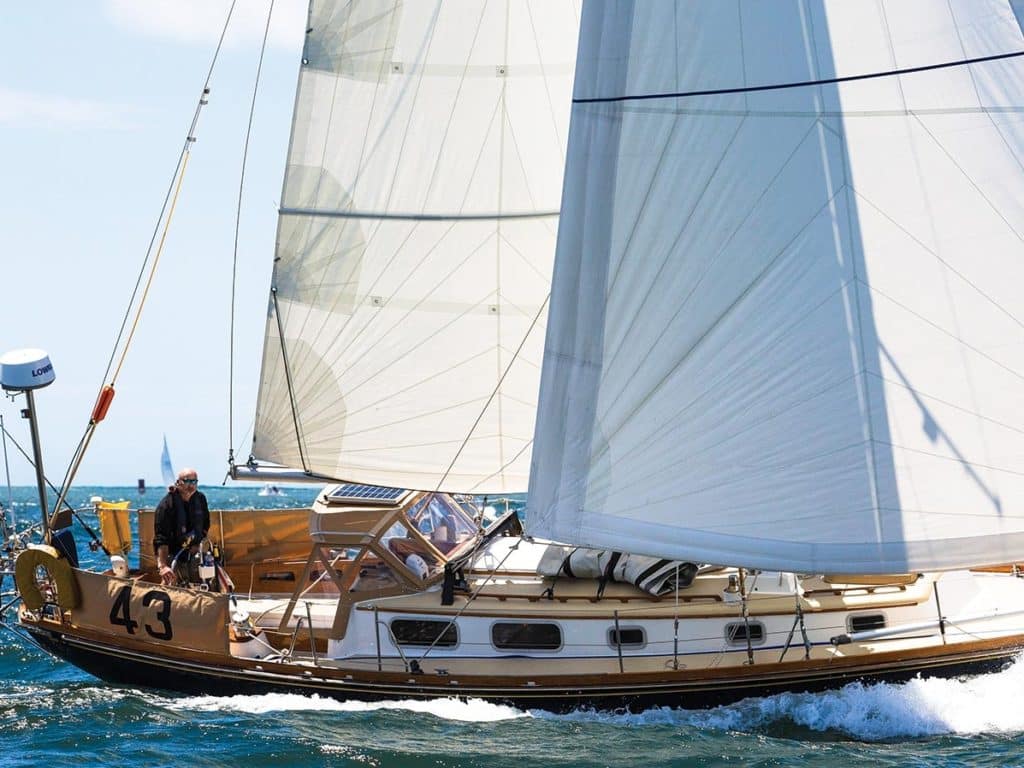
Bristol 40
Boats built in the 1960s are getting long in the tooth, but if they’ve been maintained well, they are still serviceable. And many Bristol 40s date to later years.
Designed by Ted Hood and built by Clint Pearson after he and cousin Everett sold Pearson Yachts, early Bristols have many similarities in design and construction to early Pearsons. The dominant design rule then was the CCA (Cruising Club of America), which favored short waterlines (long overhangs) and modest beam. The rule-beating idea was that when heeled, the waterline lengthened, increasing speed. A narrow boat has less form stability than a beamier hull, but is less likely to remain upside down in a capsize. A long keel with attached rudder was the accepted underwater configuration for stability and tracking.
Construction is standard for the time: mat-and-woven roving. Over time, leaky portlights and hull/deck joints became commonplace, but they can be fixed by a handy owner.A Bristol 40 won the 1983 Marion-Bermuda Race that featured close-reaching in moderate winds, which shows it’s capable of a decent day’s run. Performance also depends on rig — sloop, cutter or yawl — and keel or keel/centerboard configuration.
Early Bristol 40s were fitted with the venerable Atomic 4 gas engine for which parts may still be obtained from Moyer Marine. A Westerbeke diesel was optional; others have been re-powered with a Yanmar diesel.
Narrow beam and short waterline translate to a comparatively small interior, albeit retaining the essential separate cabins, sea berths, closed head and divided galley aft.
| DESIGNER | Ted Hood |
| LOA | 39’8” (12.1 m) |
| LWL | 27’6” (8.4 m) |
| BEAM | 10’9” (3.3 m) |
| DRAFT | 4’/7’10” cb or 5’5” (1.2 m/2.4 m or 1.6 m) |
| DISPLACEMENT | 17,580 lb. (7,974 kg) |
| BALLAST | 6,500 lb. (2,948 kg) |
| SAIL AREA | 709 sq. ft. (65.7 sq. m) |
| DISPLACEMENT/LENGTH | 377 |
| SAIL AREA/DISPLACEMENT | 16.8 |
| YEARS BUILT | 1966-1986 |
| PRICE | $29,000-$49,000 |
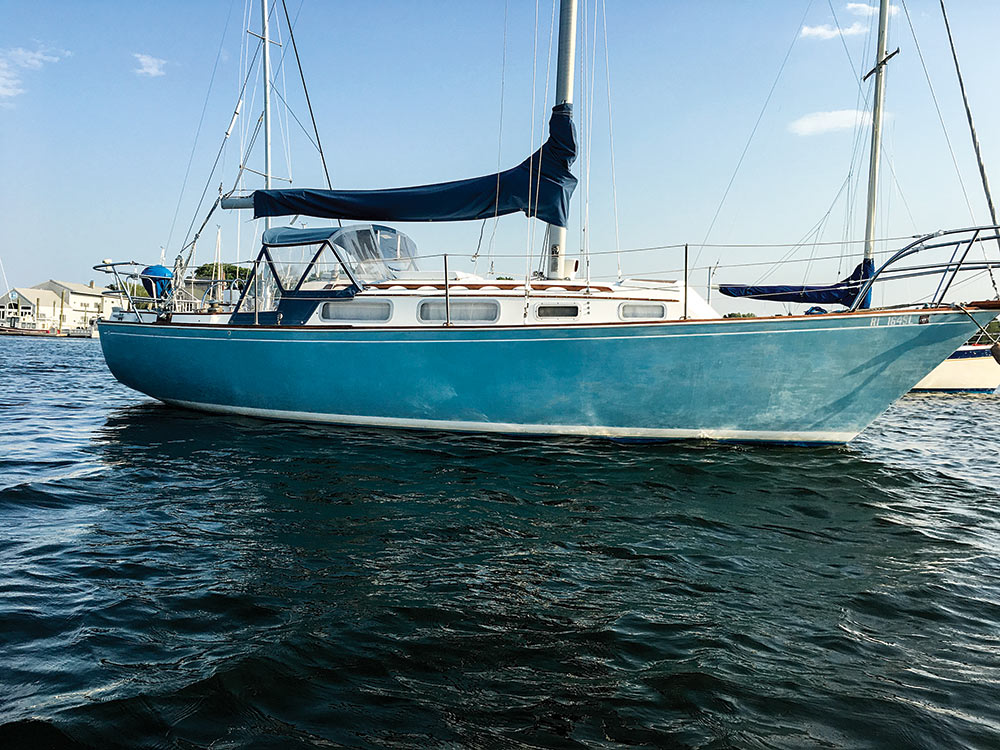
Sabre 28
Roger Hewson founded Sabre Yachts in South Casco, Maine, and launched his first model, the Sabre 28, in 1970. Whatever his qualifications as a yacht designer, he did a respectable job with the 28. The proportions are correct (beam versus waterline length, cabin height versus topsides, etc.), the deck-stepped rig conservative, the layout standard and construction quality above average. Periodic refinements were made during its 16-year production run, notably in 1976 (Mark II) and 1983 (Mark III), but the basic structure remained the same. Later models gained a few hundred pounds, which might mean the company finally got around to actually weighing a boat off the line. More than 500 were built.
At 28 feet, it’s on the small side for cruising, but of course that depends on one’s ambitions. A good indication of hull volume is the displacement/length ratio (D/L), which for this Sabre is a moderate 278, meaning decent stowage and, combined with an average sail area/displacement ratio (SA/D) of 16.6, decent performance under sail. Not exciting, but no surprises either. This is an easily handled boat despite the foretriangle being somewhat larger than the mainsail.
Some potential buyers might be skeptical of the swept-back externally ballasted keel, which at the time was thought to be more efficient than a vertical appendage. I’m sure there are Sabre 28 owners who can tell how it takes the ground and if it’ll sit upright on its keel (it depends on the center of gravity, which is not shown in the drawings).
Construction is standard hand-layup mat and woven rovings. Glass finish work is very good, and there’s a lot of teak below. Through-hulls have bronze seacocks. Early boats had Atomic 4 gas auxiliaries, and later models small Volvo or Westerbeke diesel engines.
| DESIGNER | Roger Hewson |
| LOA | 28’ (8.5 m) |
| LWL | 22’10” (6.9 m) |
| BEAM | 9’2” (2.8 m) |
| DRAFT | 3’10”/4’8” (1.2 m/1.4 m) |
| DISPLACEMENT | 7,400 lb. (3,357 kg) |
| BALLAST | 2,900 lb. (1,316 kg) |
| SAIL AREA | 393 sq. ft. (36.5 sq. m) |
| DISPLACEMENT/LENGTH | 278 |
| SAIL AREA/DISPLACEMENT | 16.6 |
| HEADROOM | 5’11” |
| YEARS BUILT | 1970-1986 |
| PRICE | $7,000-$27,000 |
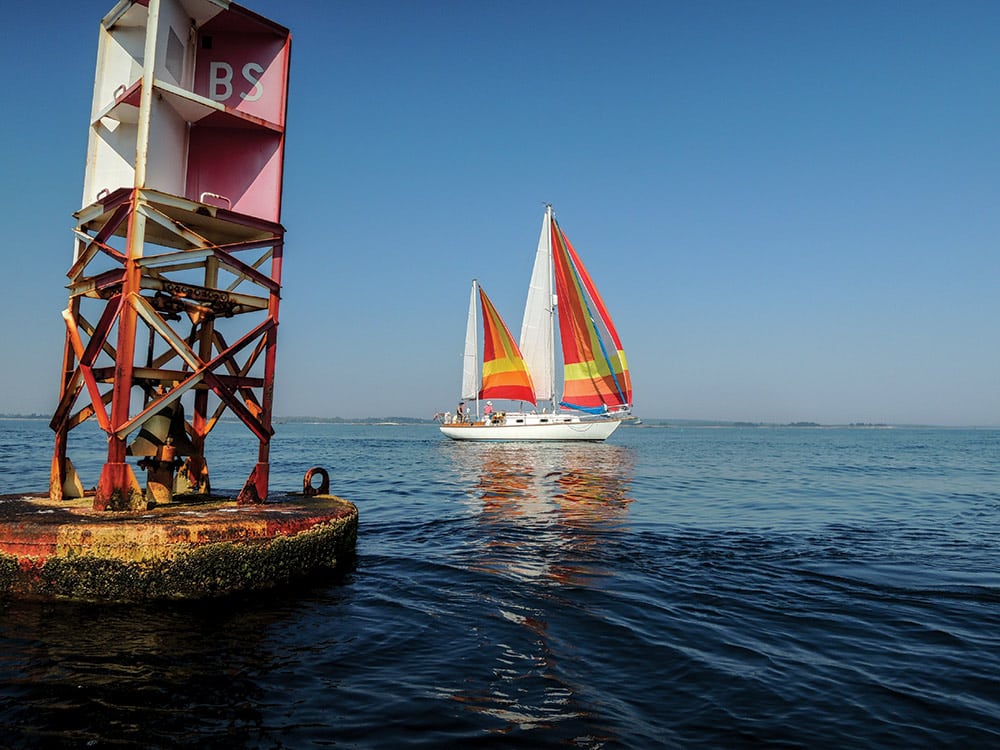
Cape Dory 30
Andy Vavolotis founded Cape Dory Yachts in 1962 with a couple of dinghies. He commissioned Carl Alberg, a Swedish-born U.S. Coast Guard naval architect, to design most of his subsequent larger yachts, including the Cape Dory 30, introduced in 1976.
This is a small 30-footer, owing to its relatively narrow beam and short waterline; the lovely, long overhangs take space from below. Vavolotis once told me that with every new model he begged Alberg to add a few inches of beam. Alberg would give him an inch or two and then say, “If you want more, find another designer. I don’t think it’s right.” That went for fin keels and spade rudders too.
Yes, it’s the full keel with attached rudder and attendant advantages (stable tracking, safety in grounding and collisions with underwater objects) that recommend the design for cruising. The downside? Increased wetted surface area translates to slower speeds, and the fat keel won’t point as high as a foil. But it’s about the journey, not speed, right? The original 30 was designed as a ketch; later renditions offered cutter and sloop rigs.
The other reason folks love Cape Dorys is robust construction. Nothing fancy: solid single-skin hull, balsa-cored deck (Aren’t they all? Well, no.), heavy bronze hardware from Vavolotis’ Spartan Marine foundry and generous exterior teak that once upon a time signified a classy yacht. Hard to believe, but true.
The Cape Dory 30 is not without a few shortcomings. The hull/deck joint is not continuously through-bolted, and some deck hardware does not have backing plates. If you’re set on a Cape Dory, I’d look for the Cape Dory MK11 updated by Clive Dent, or the 33 or 36. The latter generally sells for more than $50,000, but not by much, and it’s a roomier, more powerful design.
| DESIGNER | Carl Alberg |
| LOA | 30’3” (9.2 m) |
| LWL | 22’10” (6.9 m) |
| BEAM | 9’ (2.7 m) |
| DRAFT | 4’2” (1.3 m) |
| DISPLACEMENT | 10,000 lb. (4,530 kg) |
| BALLAST | 4,000 lb. (1,814 kg) |
| SAIL AREA | 437 sq. ft. (40.6 sq. m) |
| DISPLACEMENT/LENGTH | 375 |
| SAIL AREA/DISPLACEMENT | 15.11 |
| HEADROOM | 6’ (1.8 m) |
| YEARS BUILT | 1976-1987 |
| PRICE | $12,000-$32,000 |
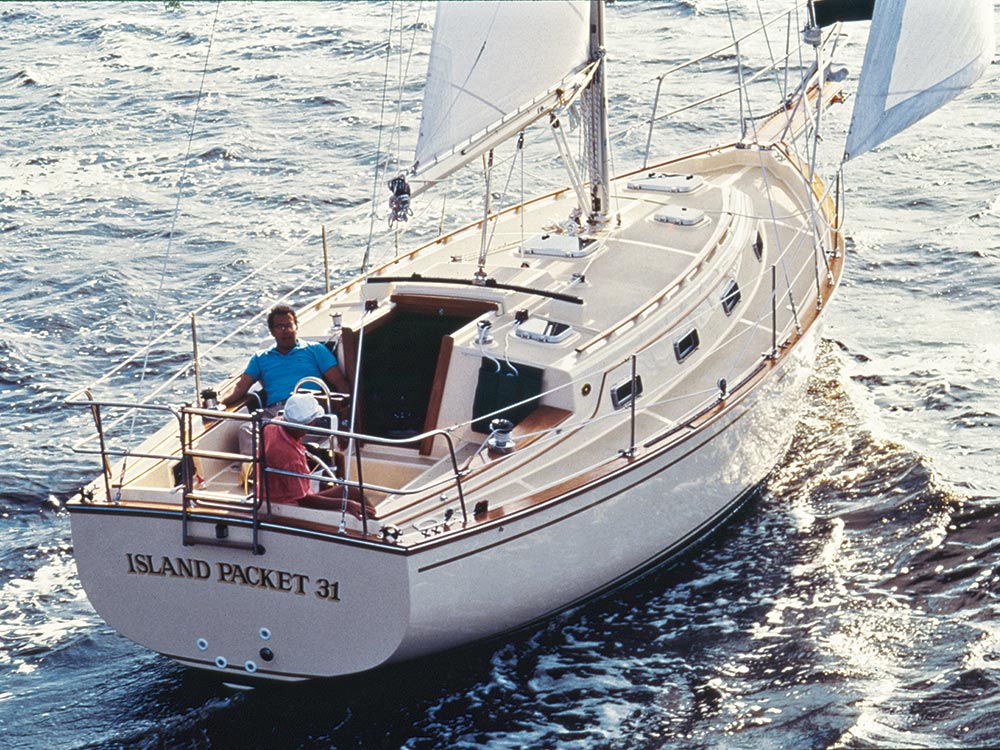
Island Packet 31
Boatbuilder and naval architect Bob Johnson shares a distinction with Cape Dory’s Andy Vavolotis as being two of the only company bosses to have offered traditional full-keel cruising boats in small sizes.
Island Packet is located in Florida, and the designs are geared for those waters, meaning shallow. To compensate for shoal draft (a 4-foot keel and 3-foot keel/centerboard were offered), the 31 has a wide beam of 11 feet 6 inches, which gives it good form stability (but not if it capsizes). Boats with wide beam and shallow draft are more likely to achieve inverse stability than narrow boats with deep keels. Ballast of iron ingots set in concrete doesn’t help. This hull form isn’t great upwind. That said, the 31 does not heel quickly and is ideally suited to Florida and Bahamas cruising grounds.
Construction is generally good. The hull is solid glass (no core), and the deck is an exception to the usual end-grain balsa core; a mixture of polyester resin and microballoons called PolyCore forms a chemical bond between the two skins of the “sandwich,” eliminating the possibility of rot and delamination. Like many builders of series-produced boats, Island Packet incorporated a large molded liner or pan that forms the cabin sole, berth flats, galley and other “furniture” features. It saves labor costs but can cause condensation, increase noise and vibration compared to plywood, and make access to parts of the hull potentially difficult. What it does do is discourage radical customizing, which may be a good thing, given the weird stuff some guys cobble together (think a Barcalounger in place of a saloon settee).
| DESIGNER | Bob Johnson |
| LOA | 30’7” (9.3 m) |
| LWL | 27’9” (8.5 m) |
| BEAM | 11’6” (3.5 m) |
| DRAFT | 3’/4’ (0.9 m/1.2 m) |
| DISPLACEMENT | 11,000 lb. (4,991 kg) |
| BALLAST | 4,500 lb. (2,042 kg) |
| SAIL AREA | 531 sq. ft. (49.4 sq. m) |
| DISPLACEMENT/LENGTH | 230 |
| SAIL AREA/DISPLACEMENT | 17.2 |
| YEARS BUILT | 1983-1989 |
| PRICE | $35,000-$50,000 |
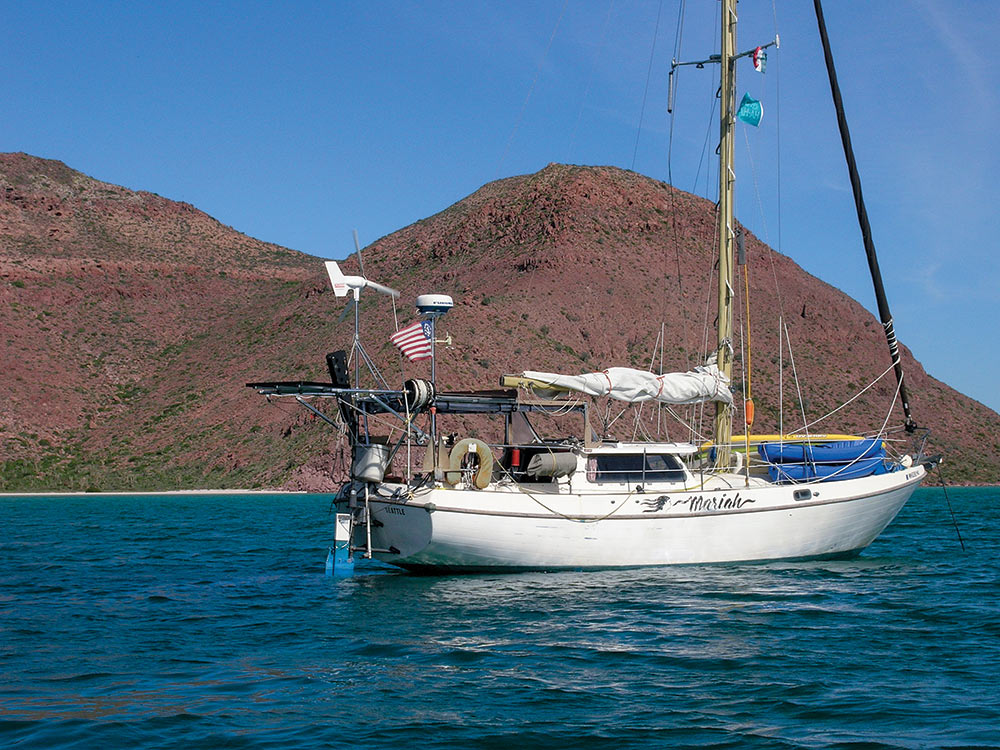
Gulf 32
It’s too bad more of these able cruisers haven’t migrated farther from their origin on the West Coast. While rather plainly finished, construction is solid and the pilothouse with inside steering is unusual. The sweeping sheer, flush cambered deck and low-profile pilothouse make what could be an ungainly profile actually quite handsome.
As with so many models produced over a decade and longer, changes were made to the Gulf 32 over its 400-unit run, in part because it was built by two different companies: Gulf Marine Products and Capital Yachts. For example, the drawings show an offset double berth forward, while others were delivered with the more conventional V-berth. While the interior features a lot of warm wood finishes, including bulkheads, the large interior liner is startlingly evident in places such as the forward cabin. Noteworthy is the sail area/displacement ratio of 11.6 and displacement/length ratio of 563. These are motorsailer numbers.
Prospective buyers should carefully check the cored side decks for delamination; this is a good time to state unequivocally that a boat with extensive deck delamination is probably not worth repairing. The cost to have a yard perform the repairs is very likely more than the boat is worth. A competent DIY repair is difficult; drilling numerous holes in the top skin and injecting epoxy over a large area is unlikely to do the job. The radical alternative is to remove the inner skin and core and then replace the core and skin, all while working upside down. I know of a person who tried this, using spring-loaded curtain rods to hold backing panels in place — they don’t call him “Resin-head” for nothing.
| DESIGNER | William Garden |
| LOA | 32’ (9.8 m) |
| LWL | 23’4” (7.1 m) |
| BEAM | 10’ (3.1 m) |
| DRAFT | 4’2” (1.6 m) |
| DISPLACEMENT | 16,000 lb. (7,258 kg) |
| BALLAST | 6,500 lb. (2,948 kg) |
| SAIL AREA | 458 sq. ft. (42.6 sq. m) |
| DISPLACEMENT/LENGTH | 563 |
| SAIL AREA/DISPLACEMENT | 11.6 |
| YEARS BUILT | 1965-1990 |
| PRICE | $24,000-$39,000 |
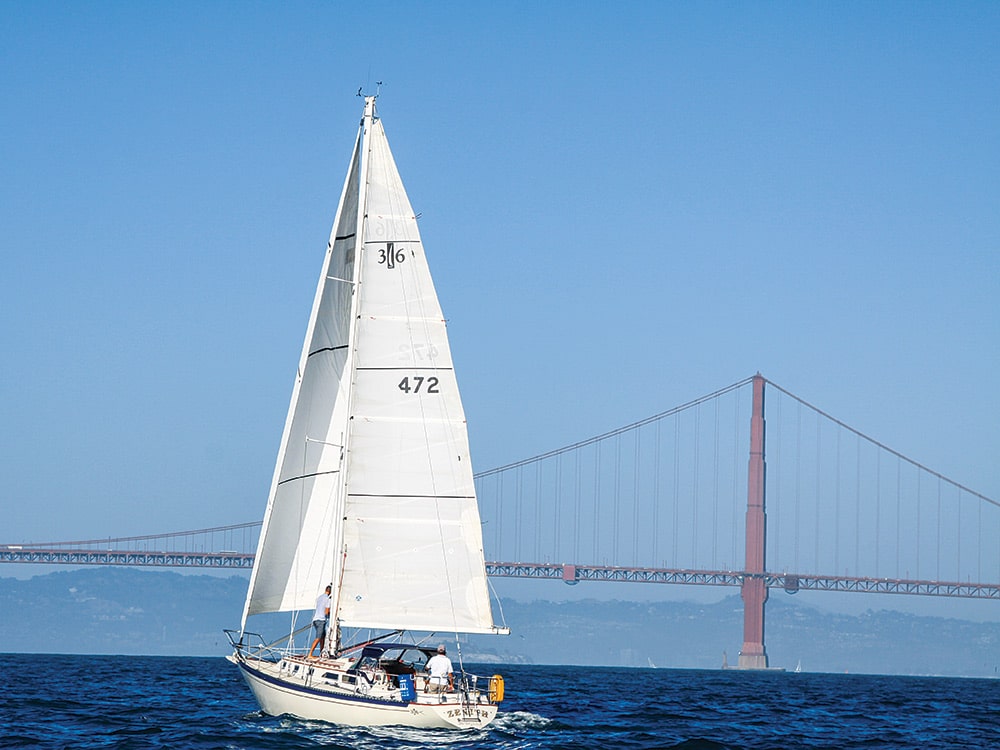
Islander 36
Once upon a time in Costa Mesa, California, the mecca of early fiberglass boatbuilding, Islander Yachts was a worthy competitor of Columbia and Cal. Australian designer Alan Gurney drew this fast, International Offshore Rule-influenced hull with pinched ends, fin keel and skeg-mounted rudder. A word about skegs: It’s widely believed that they protect the rudder, but the degree to which they succeed depends on the internal structure of the skeg. If it’s simply a piece of molded glass tabbed to the hull, it will likely tear away on impact. If, however, it has, say, a metal backbone well connected to the hull, that’s stronger. In either case, a skeg also is a simple means to provide a lower bearing for the rudder, add some lateral surface for tracking and reduce bending moment. The IOR hull type goes upwind well, but can be squirrelly off the wind, especially with a spinnaker. Rig dimensions varied over the years.
Construction is conventional: solid fiberglass hull but plywood in the deck, as opposed to the more common end-grain balsa wood. It’s heavier and more prone to rot. Different engines were offered. Tankage for fuel and water is on the small side, so consider adding a bladder tank for longer periods aboard.
With the Islander 36, naval architect Robert Perry credits interior designer Joe Artese with revolutionizing sailboat accommodations — no longer a “boy’s cabin in the woods.” Artese took advantage of the boat’s wide beam to increase sole area; drew a wide, low companionway; designed a foldaway table; and specified contemporary fabrics. Somewhere close to 1,000 were sold.
| DESIGNER | Alan Gurney |
| LOA | 36’1” (11 m) |
| LWL | 28’4” (8.6 m) |
| BEAM | 11’2” (3.4 m) |
| DRAFT | 4’8”/6’1” (1.4 m/1.9 m) |
| DISPLACEMENT | 13,450 lb. (6,101 kg) |
| BALLAST | 5,820 lb. (2,640 kg) |
| SAIL AREA | 576 sq. ft. (553.6 sq. m) |
| DISPLACEMENT/LENGTH | 266 |
| SAIL AREA/DISPLACEMENT | 16.4 |
| YEARS BUILT | 1971-1986 |
| PRICE | $22,000-$49,000 |
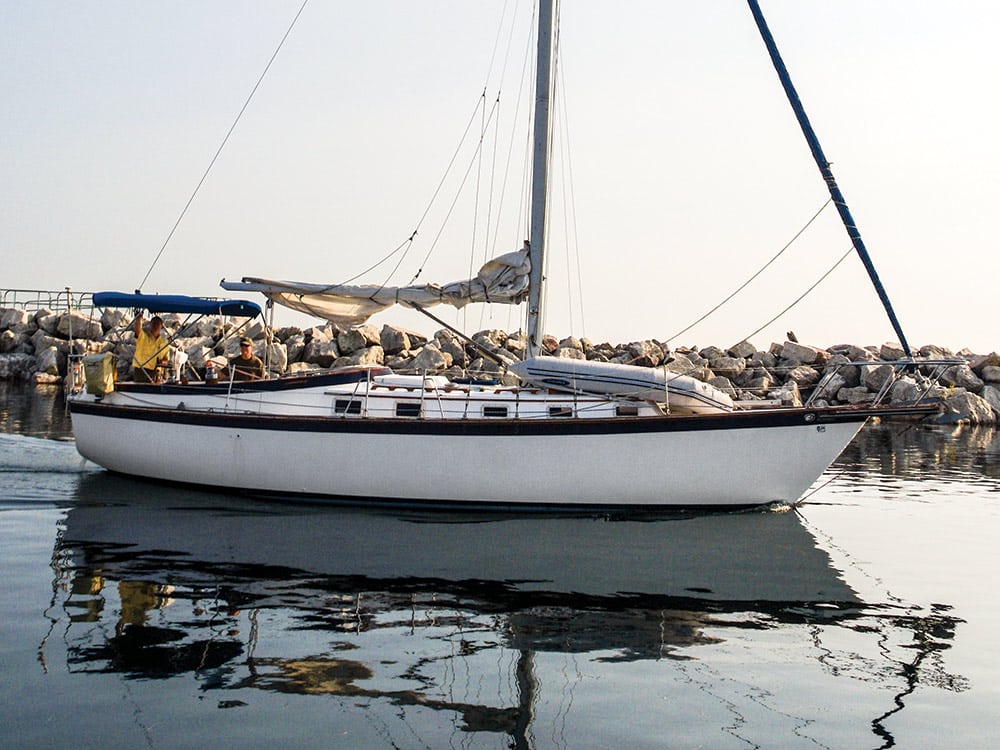
Endeavour 37
The design of this boat is a great example of the ingenuity and craftiness of the fiberglass boatbuilding industry. Endeavour founders Rob Valdez and John Brooks, both of whom had worked for Vince Lazzara at Gulfstar, got started when Ted Irwin gave them the molds for the Irwin 32. The Endeavour 32 sold well, so in looking for their next model, they found the derelict mold of the Creekmore 34 on the Miami River, cut it in half, added 3 feet and voilà! The Endeavour 37!
And there is a sort of Frankenstein look to the boat. Most were sold as sloops, though a ketch rig was offered. It’s a heavy, slow boat, but comfortable and solidly built, with single-skin hull and plywood interior components (no fiberglass pan). Workmanship is generally quite good. If a previous owner hasn’t switched the gate valves on through-hulls to seacocks, add it to your work list. Ballast is internal. The standard engine was the workhorse Perkins 4-108 diesel.
Two interior plans were offered: the A layout, with convertible dinette forward and two aft cabins, and the B layout, with V-berth forward and a single aft cabin. Having slept in one of them I can say that they are not easy to get in and out of. Better to consider them larger-than-usual quarter berths.
Upwind sailing performance is poor — it doesn’t point well — making you appreciate the strong diesel auxiliary. Motion is comfortable; like the Gulf 32, the D/L and SA/D are motorsailer numbers.
| DESIGNER | Endeavour Yachts |
| LOA | 37’5” (11.4 m) |
| LWL | 30’ (11.3 m) |
| BEAM | 11’7” (3.5 m) |
| DRAFT | 4’ 7” (1.4 m) |
| DISPLACEMENT | 21,000 lb. (9,513 kg) |
| BALLAST | 8,000 lb. (3,630 kg) |
| SAIL AREA | 580 sq. ft. (54 sq. m) |
| DISPLACEMENT/LENGTH | 341 |
| SAIL AREA/DISPLACEMENT | 12.2 |
| YEARS BUILT | 1977-1983 |
| PRICE | $20,000-$49,000 |
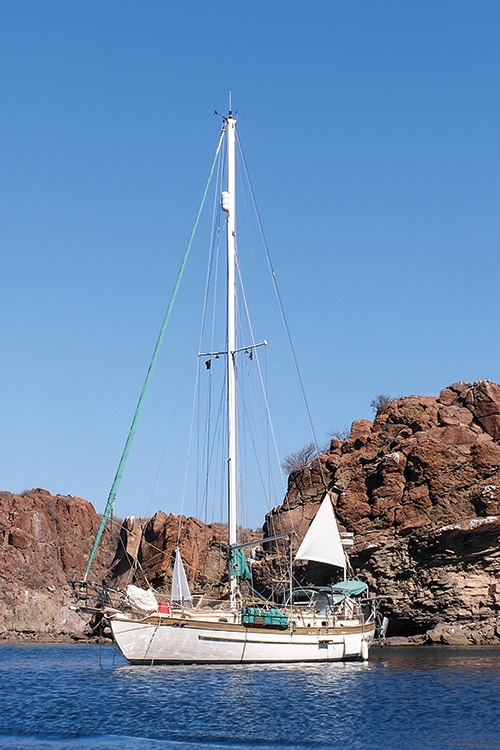
Tayana 37
Designer Robert Perry is proud to tell fans that during George Day’s circumnavigation in the 1990s, the former Cruising World editor said he saw more double-ended Tayana 37s “out there” than any other model. It’s no wonder: some 650 were built, and it is indeed a strong, well-designed cruiser.
The first boats produced in Taiwan were called the CT 37, changing to Tayana 37 around 1979; Perry says they are the same. Early Taiwan yards were never into racing yachts, but rather heavy, low-tech cruising boats. The Tayana 37 has a solid fiberglass hull and balsa-cored deck. The potentially leaky hull/deck joint is a hollow box section that forms the bulwark.
As with nearly every model produced over a long period of time, there were variations in accommodations, rig, deck and more (many were never officially documented in literature, so don’t be surprised if what you see in brochures is not what you behold in real life). Builder Ta Yang offered free or inexpensive customizations of the 37.
While Perry specified the 90-gallon (341-liter) fuel tank to be located amidships, early boats placed them under the V-berth, which, combined with heavy ground tackle, can trim the boat down by the bow.
The high-aspect-ratio rig, aided by a bowsprit to increase foretriangle area, gives the boat plenty of power. It was offered as a ketch or cutter, and most owners opted for the latter.
As with most boats from Taiwan, the interior is richly executed in teak, built up in plywood. Much of the hardware are knockoffs of U.S. and European products, and of varying quality. All in all, the Tayana 37 is a well-built world cruiser.
| Designer | Robert Perry |
| LOA | 36’8” (11.2 m) |
| LWL | 31’10” (9.7 m) |
| Beam | 11’6” (3.5 m) |
| Draft | 5’8” (1.7 m) |
| Displacement | 24,000 lb. (18,889 kg) |
| Ballast | 7,340 lb. (3,330 kg) |
| Sail area | 864 sq. ft. (80.4 sq. m) |
| DISPLACEMENT/LENGTH | 332 |
| SAIL AREA/DISPLACEMENT | 16.6 |
| YEARS BUILT | 1976-2016 |
| PRICE | $34,000-$49,000 |
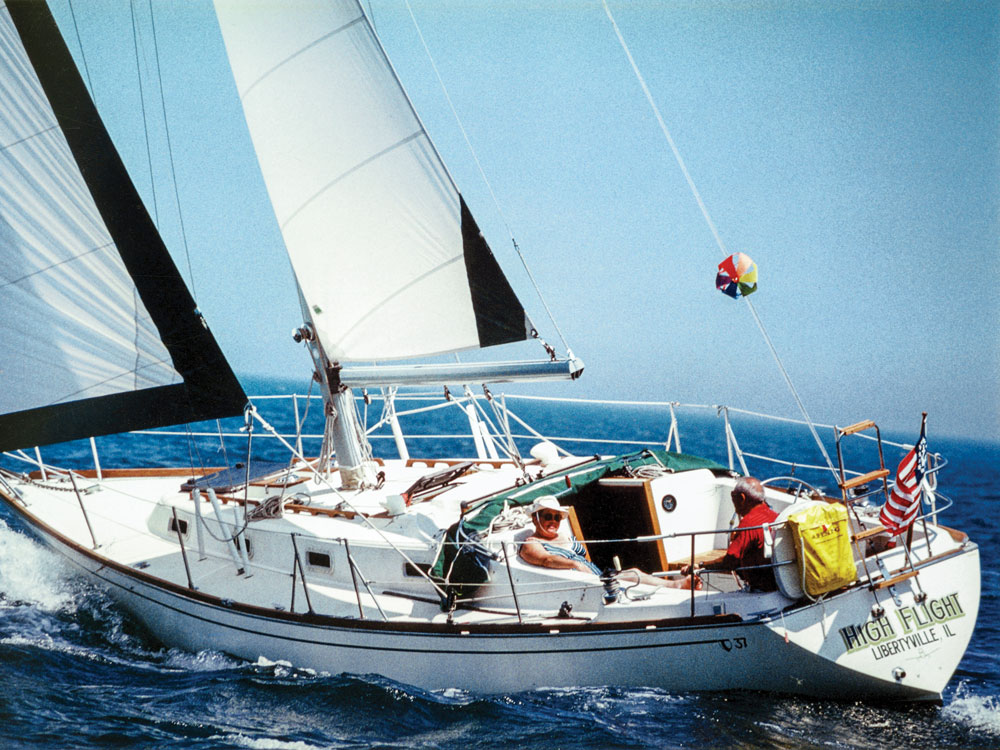
Tartan 37
Tartan Marine has built three 37-footers over the years, the first in 1965 designed by Ted Hood; the 3700 designed by in-house designer and then general manager Tim Jackett; and the most numerous, the Tartan 37 designed by Sparkman & Stephens, of which nearly 500 units were sold. It’s a handsome boat with perfect proportions. Somewhat influenced by the IOR, the ends are narrow and the transom is small and V-shaped. That’s about all that hasn’t withstood the test of time.
Construction quality is excellent: balsa-cored hull and deck, teak trim and teak-veneer plywood, external lead ballast. The bulkheads are tabbed to the deck, which is worthy of comment. Boats with molded fiberglass headliners cannot have the bulkheads tabbed (several layers of fiberglass tape or strips that overlap the deck and bulkhead). Instead, there are usually grooves molded into the headliner into which the bulkheads fit and are then variously bolted or glued — or not. This is considered less desirable than tabbing, which locks in the entire structure and eliminates the possibility of slight movement or working of those with molded fiberglass liners.
Most 37s were delivered with the keel/centerboard option; the deep keel performs better but may limit where you can go. Performance Handicap Racing Fleets around the country rate it at 132 to 144; for comparison, a J/30 rates 144, as does the Islander 36 described above. So, the Tartan sails fast and handles well, leaning more toward a club racer/cruiser than all-out cruising.
| DESIGNER | Sparkman & Stephens |
| LOA | 37’3” (11.4 m) |
| LWL | 28’6” (8.7 m) |
| BEAM | 11’9” (3.6 m) |
| DRAFT | 4’2” cb/6’7” (1.3 m/2 m) |
| DISPLACEMENT | 15,500 lb. (7,031 kg) |
| BALLAST | 7,500 lb./7,200 lb. (3,405 kg/3,267 kg) |
| SAIL AREA | 625 sq. ft. (58 sq. m) |
| DISPLACEMENT/LENGTH | 294 |
| SAIL AREA/DISPLACEMENT | 16.1 |
| YEARS BUILT | 1976-1989 |
| PRICE | $23,000-$49,000 |
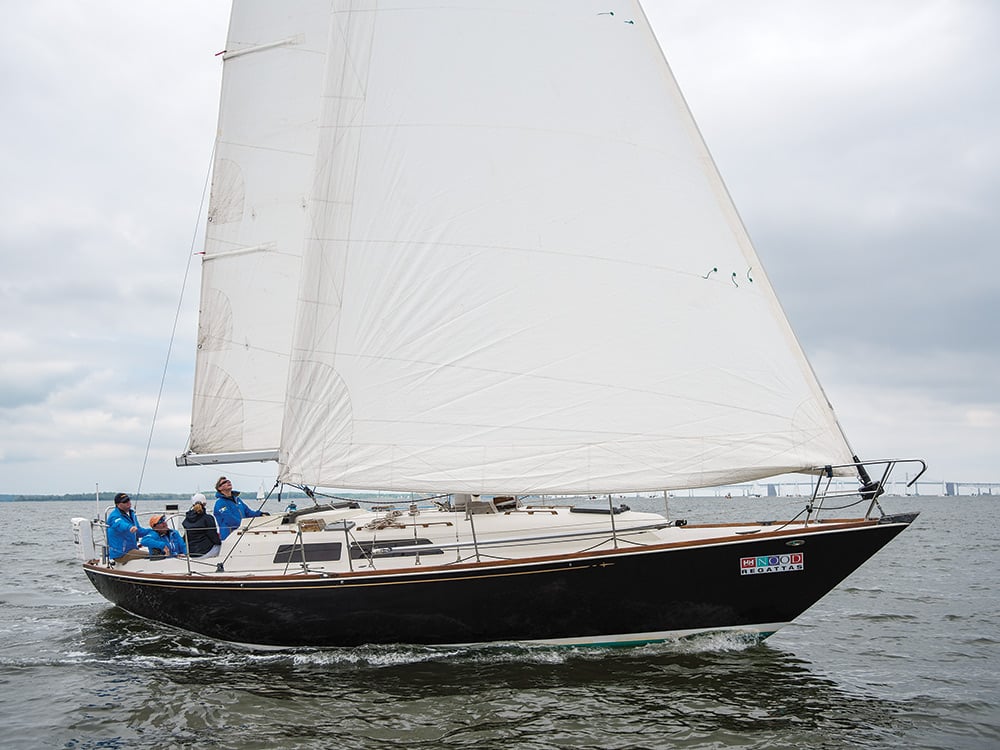
C&C Landfall 38
Hull design and construction for coastal cruising may certainly favor higher performance models, and few companies knew the recipe better than C&C Yachts. In many ways, C&Cs exemplify the racer/cruiser genre. The few Landfall models, including the 38 here, tipped the scales more toward cruising, while retaining excellent sailhandling and speed.
A few years into production, 1,700 pounds were added, but performance is still sparkling, and similar to the original 38. The fin keel has a flat bottom that can be considered a cruising fin for its moderate surface area and ability to sit on the bottom. As for the spade rudder and the criticism it takes for vulnerability, note that circumnavigator and boatbuilder Steve Dashew says it gives superior control hove-to in a gale. Something to think about.
C&C was a pioneer in composite construction, that is, end-grain balsa coring in the hull and deck to increase stiffness and reduce weight. Other notable features: through-bolted deck hardware with backing plates, bronze seacocks and, in the 38, a keel-stepped mast that doesn’t sit corroding in bilge water. Yanmar diesels were standard.
Albeit modified from the IOR-influenced C&C 38, the Landfall 38 still has a large foretriangle; a 150 percent genoa measures 580 square feet, which can be a handful for a couple. Big self-tailing winches will help when trimming the beast.
The interior, elegantly finished in teak, is somewhat unusual; like the Endeavour 37, it incorporates a double-berth aft cabin, but think of it more as a wide quarter berth.
Compared to heavy full-keel designs, the Landfall 38 will point higher, reducing the number of tacks between points A and B, which, combined with greater boat speed, means getting to port faster.
| DESIGNER | Cuthbertson and Cassian |
| LOA | 37’7” (11.5 m) |
| LWL | 30’2” (9.2 m) |
| BEAM | 12’ (3.7 m) |
| DRAFT | 4’11” (1.5 m) |
| DISPLACEMENT | 16,700 lb. (7,577 kg) |
| BALLAST | 6,500 lb. (2,949 kg) |
| SAIL AREA | 649 sq. ft. (60.4 sq. m) |
| DISPLACEMENT/LENGTH | 272 |
| SAIL AREA/DISPLACEMENT | 15.9 |
| YEARS BUILT | 1979-1987 |
| PRICE | $33,000 |








